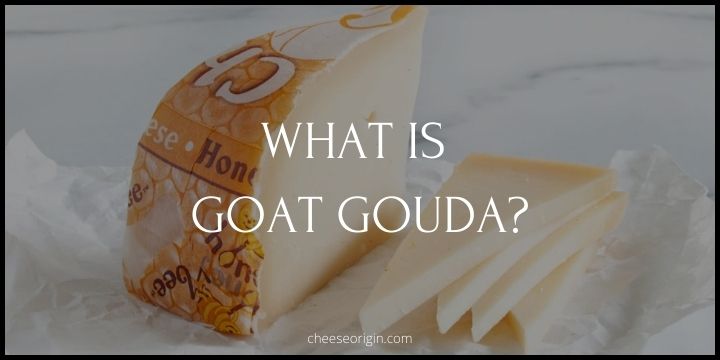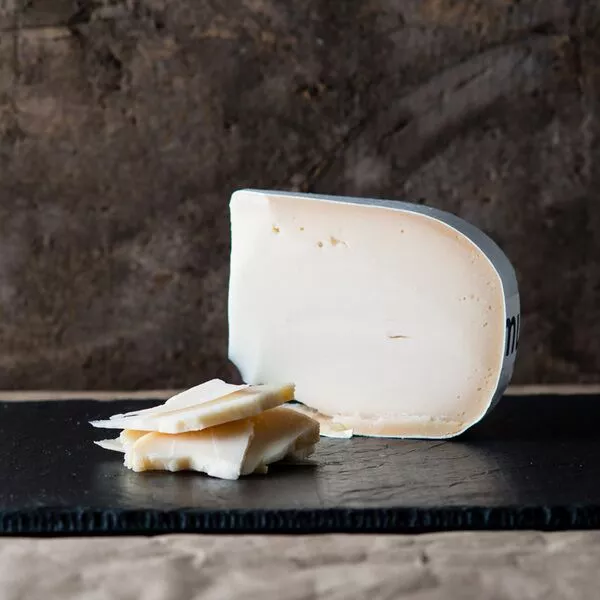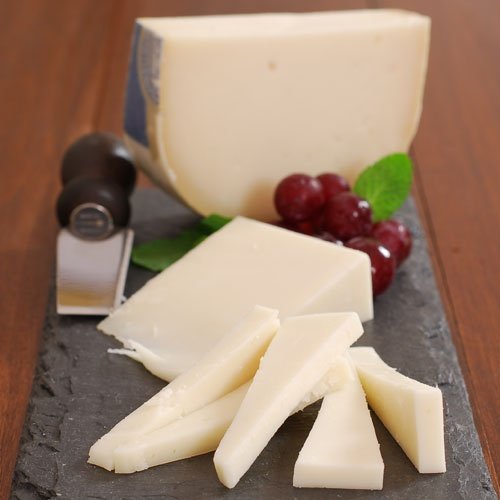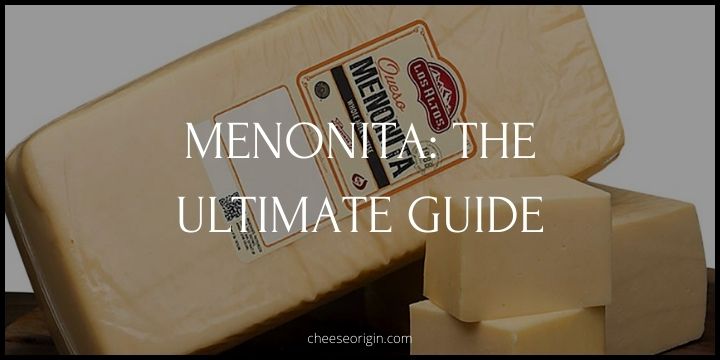What is Goat Gouda? A Refreshing Twist on a Dutch Classic

Welcome, cheese enthusiasts! Ever heard of Goat Gouda? If not, you’re in for a delightful surprise. This Dutch classic, traditionally made with cow’s milk, has been given an intriguing twist with goat’s milk. The result? A unique and refreshing cheese, full of character and flavor.
Perfect for those looking to explore beyond the familiar realms of cheese, Goat Gouda offers a new perspective on an old favorite.
Quick Facts About Goat Gouda
| Quick Facts | Details |
|---|---|
| Origin | Netherlands |
| Texture | Sandwiches, pasta, salads, and cheese boards |
| Color | Creamy white to light yellow |
| Aging Time | 4-10 weeks |
| Flavor | Sweet, nutty with a hint of caramel |
| Aroma | Mild, slightly tangy |
| Melting Ability | Excellent |
| Pairings | Fruits, nuts, honey, and light-bodied wines |
| Shelf Life | Up to 2 months when properly stored |
| Nutrition (per 100g) | 356 calories, 29g fat, 24g protein |
| Popular Uses | Sandwiches, pastas, salads, and cheese boards |
| Notable Feature | Lower in lactose compared to cow’s milk cheeses |
What is Goat Gouda?

Goat Gouda, an often overlooked member of the cheese family, is a Dutch delight that deserves its moment in the culinary spotlight. Born in the verdant pastures of the Netherlands, this semi-hard cheese is crafted from the rich, creamy milk of goats rather than cows. Its unique origins lend it a flavor profile that’s refreshingly different from its cow-milk counterpart.
The color of Goat Gouda ranges from a creamy white to a light, sun-kissed yellow, and its texture is pleasingly firm yet smooth. With an aging time typically between 4 to 10 weeks, this cheese undergoes a transformation that deepens its flavors and enhances its inherent creaminess.
The flavor of Goat Gouda is another delightful surprise, offering a sweet and nutty taste that’s punctuated by a hint of caramel. It’s not overly pungent, but instead, presents a mild aroma that’s slightly tangy. This makes it a versatile option for a variety of dishes, from sandwiches and pastas to salads and cheese boards.
One of the notable features of Goat Gouda is its lower lactose content compared to cow’s milk cheeses, making it a more digestible choice for those with lactose sensitivities.
So, if you’re looking to venture beyond the familiar terrain of traditional cheeses, why not give Goat Gouda a try? Its unique characteristics and delightful taste may just make it your new favorite.
What Does Goat Gouda Taste Like?
Goat Gouda is a cheese that appeals to a wide range of palates, even those who might find traditional goat cheese too strong or “gruff”. It’s often described as sweet and supple, with a distinctive hint of caramel adding to its depth of flavor.
Despite being made from goat’s milk, it doesn’t have an overpowering “goaty” flavor. This makes it a great recommendation for those who are not typically fans of goat’s milk cheese. The aging process also contributes to its unique taste, allowing for a contrast of flavors to develop.
When you cut into Goat Gouda, you’ll experience an aromatic burst of fruity and caramel notes, reminiscent of the sun-soaked hills where the goats graze. Its ivory-colored paste further enhances the sensory experience.
This cheese is versatile and can be enjoyed in various ways. It can make a delicious grilled cheese sandwich, and it’s also a safe choice for a cheese board, especially when you’re unsure of your guests’ tastes.
Contrary to common misconceptions about goat cheese, not all varieties boast pungent flavors and smells. Goat Gouda, for example, is milder and more universally appealing.
In comparison to classic aged Gouda, which boasts a warm golden hue, Goat Gouda has a milky pale color. However, this doesn’t detract from its appeal – on the contrary, first-timers are often pleasantly surprised by its taste.
Goat Gouda Tasting Notes
- Appearance: Goat Gouda is typically a creamy white to light yellow in color. The cheese has a natural, edible rind that can range from tan to orange.
- Texture: This semi-hard cheese offers a firm yet smooth texture. As it ages, it can develop small, crunchy protein crystals that add a pleasing contrast.
- Aroma: Goat Gouda has a mild, slightly tangy scent. The aroma is not overly pungent, but rather has a fresh, clean smell that hints at its origins in the lush Dutch pastures.
- Flavor: The taste of Goat Gouda is sweet and nutty, with a hint of caramel that develops as the cheese ages. It doesn’t have the strong “goaty” flavor that some might expect, but instead presents a more nuanced profile that’s easy on the palate.
- Aftertaste: The aftertaste of Goat Gouda is clean and fresh, leaving a pleasantly sweet and slightly tangy impression that lingers on the tongue.
- Pairings: Goat Gouda pairs well with a variety of foods and drinks. Try it with fruits like apples and grapes, nuts like almonds, crusty breads, or honey. For drinks, it goes well with white wine, beer, or cider.
- Dietary Notes: Goat Gouda is lower in lactose than cow’s milk cheeses, making it a good option for those with lactose sensitivities. It’s also a good source of protein and calcium.
What is the Difference Between Goat Gouda and Goat Cheese?
| Goat Cheese (Chevre) | Goat Gouda | |
|---|---|---|
| Production Methods | Made by curdling goat’s milk with lemon juice or other acids. Usually consumed fresh. | Follows a traditional Dutch cheesemaking process and is aged for several months. |
| Taste | Distinctively tangy, often with a strong “goaty” flavor. | Milder, sweet, and nutty, becoming caramel-like as it ages. Less of a “goaty” flavor. |
| Texture | Soft and spreadable. | Semi-hard and firm. Can develop crunchy protein crystals as it ages. |
| Aging Process | Typically consumed fresh and not aged for long periods. | Aged for several months to develop its unique flavor profile. |
| Uses | Often used in salads, spread on crackers or bread, or used in cooking due to its soft texture. | Can be sliced for sandwiches, grated over dishes, or eaten on its own with fruit and nuts due to its firmness. |
While both Goat Gouda and goat cheese are derived from goat’s milk, they offer different culinary experiences due to their varying production methods, flavors, textures, and uses.
How to Eat Goat Gouda?
- Savor it Solo: Enjoy a slice of Goat Gouda on its own to truly appreciate its unique sweet, nutty flavor and creamy texture. This allows you to experience the cheese in its purest form.
- Cheese Board Extravaganza: Incorporate Goat Gouda into your cheese board. Its distinctive taste adds a new dimension to the assortment. Pair it with honey, fig jam, or a spicy chutney for a delightful contrast of flavors.
- Culinary Creations: Use Goat Gouda in your culinary creations like quiches, tarts, or savory pies. Its excellent melting quality makes it a great baking cheese.
- Pair with Fresh or Dried Fruit: The sweetness of fruits like apples, pears, dried apricots, or figs complements the flavor of Goat Gouda. This combination can serve as a refreshing appetizer or a light dessert.
- Sprinkle Over Salads or Pastas: Grate Goat Gouda over your favorite salads or pasta dishes. It brings a gourmet touch and an interesting flavor profile to everyday meals.
- Delicious Sandwich Companion: Add thin slices of Goat Gouda to your sandwiches or burgers. Its creaminess pairs well with various ingredients, enhancing the overall taste.
- Wine or Craft Beer Pairing: Enjoy Goat Gouda with a glass of wine or craft beer. Its flavor pairs nicely with a range of beverages from crisp white wines to full-bodied reds, and from hoppy IPAs to rich stouts.
- Gourmet Snack with Crackers: Layer slices of Goat Gouda on artisanal crackers for a simple yet gourmet snack. Add some roasted nuts or olives on the side for extra flavor and texture.
10 Best Goat Gouda Substitutes
| Goat Gouda Substitute | Description |
|---|---|
| Goat Cheddar | Similar goat milk base, but with a sharper flavor. A good substitute if you want a bit more tanginess. |
| Gouda (Cow’s Milk) | Made using the same process as Goat Gouda, but with cow’s milk. The flavor is slightly different, but it’s a good alternative if you’re not a fan of the “goaty” taste. |
| Edam | Another Dutch cheese, Edam has a similar texture to Goat Gouda and a mildly sweet flavor. |
| Jarlsberg | This Norwegian cheese has a mild, nutty flavor and a semi-hard texture, making it a good match for Goat Gouda. |
| Emmental | A Swiss cheese with a sweet, fruity flavor and a firm texture. Emmental can be used in many of the same ways as Goat Gouda. |
| Muenster | An American cheese with a smooth, creamy texture. Muenster melts well, making it a good substitute in cooked dishes. |
| Fontina | This Italian cheese is slightly creamier than Goat Gouda, but has a similar nutty flavor. Fontina also melts well. |
| Comté | A French cheese with a complex, nutty flavor. Comté is firmer than Goat Gouda, but can be used in many of the same applications. |
| Provolone | An Italian cheese that is semi-hard like Goat Gouda. Provolone has a mild flavor that can complement many dishes. |
| Manchego | This Spanish cheese is firmer and slightly more pungent than Goat Gouda, but its nutty, caramel-like flavor makes it a good alternative. |
What Pairs Well With Goat Gouda?

Food that goes well with Goat Gouda:
| Category | Food that goes well with Goat Gouda |
|---|---|
| Fruits | Apples, Pears, Grapes, Dried Apricots, Figs |
| Nuts & Seeds | Almonds, Walnuts, Pecans, Pumpkin Seeds |
| Breads & Crackers | Sourdough Bread, Whole Grain Crackers, Baguette, Rye Bread |
| Meats & Poultry | Smoked Ham, Roast Turkey, Salami, Prosciutto |
| Condiments & Spreads | Honey, Fig Jam, Spicy Chutney, Stone-Ground Mustard |
| Vegetables | Grilled Asparagus, Roasted Bell Peppers, Marinated Olives, Sun-dried Tomatoes |
| Sweet Treats | Dark Chocolate, Caramel Treats, Fruit Pastes |
| Seafood | Smoked Salmon, Grilled Shrimp, Tuna Tartare |
| Grains & Pasta | Quinoa Salad, Pasta with Olive Oil and Garlic, Farro Salad |
| Other Cheeses | Brie, Aged Cheddar, Blue Cheese, Camembert |
Also read: What Fruit Goes on a Charcuterie Board?
Beverage that goes well with Goat Gouda:
| Category | Beverage that goes well with Goat Gouda |
|---|---|
| White Wine | Sauvignon Blanc, Chardonnay, Pinot Grigio |
| Red Wine | Merlot, Pinot Noir, Cabernet Sauvignon |
| Beer | Belgian Ale, IPA (India Pale Ale), Stout |
| Non-Alcoholic Drinks | Apple Cider, Pear Juice, Herbal Tea |
| Sparkling Wine | Prosecco, Champagne, Cava |
| Dessert Wine | Port, Sherry, Madeira |
| Cocktails | Old Fashioned, Whiskey Sour, Negroni |
| Spirits | Whiskey, Brandy, Aged Rum |
| Ciders | Dry Apple Cider, Pear Cider, Spiced Cider |
Also read: Top 10 Champagne & Cheese Pairings to Try at Least Once
Frequently Asked Questions
1. Is Goat Gouda a good melting cheese?
Yes, Goat Gouda is a good melting cheese. Younger Gouda, including Goat Gouda, is known for its excellent melting qualities. It offers a firm texture and a salty-sweetness that makes it a great choice for various culinary applications. Despite its ability to melt well, it retains a smooth, supple texture that enhances dishes without overpowering them.
However, it’s important to note that aged Gouda, which may include Goat Gouda, doesn’t melt as well as the younger varieties.
2. How long does Goat Gouda last?
Goat Gouda, when properly stored, can last up to two months unopened. Once opened, it typically remains good for about 1 to 2 weeks. However, always check the expiration date on the packaging and examine the cheese for any signs of spoilage, such as mold or off-smell, before consuming.
Also read:
- What is Aged Gouda? The Art of Aging
- What is La Vache Qui Rit? The Laughing Cow Cheese
- What is Berkswell? The Rustic Gem of English Cheeses
- What is Double Gloucester? The Taste of English Tradition
- What is Longhorn Cheese? The Mild and Buttery Delight from America
- What is Mozzarella di Bufala? Behind the Creaminess





